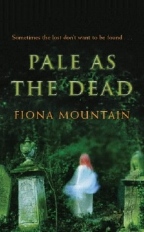Pale as the Dead
Fiona Mountain
Orion
UK Hardback
ISBN: 0752841106
Pages: 280; Price: £17.99
Publication Date: August 7, 2003
Date Reviewed: 3 October 2004
Reviewed by: Serena Trowbridge © 2004

REFERENCES
COLUMNS
|
|
|
Pale as the DeadFiona MountainOrionUK HardbackISBN: 0752841106Pages: 280; Price: £17.99Publication Date: August 7, 2003Date Reviewed: 3 October 2004Reviewed by: Serena Trowbridge © 2004 |
|
|
REFERENCES |
COLUMNS |
I am dubious about modern novels that mess with history. Things are as they are (or were), and rewriting bits of it to suit literary ends is not often either appropriate or successful. Pale as the Dead is, however, an exception. It features twenty eight year old Natasha Blake, an "ancestor detective", or genealogist, whose job it is to mess with history, or at least to find out surprising things. People come to her asking how she can trace their past, looking at their predecessors and usually thereby helping them in the present. This novel, the first of a series featuring Natasha, sees a young girl, Bethany, who poses as Ophelia and identifies with Lizzie Siddal, the tragic model of the Pre-Raphaelite Brotherhood. Bethany knows that she has a family history related to the Pre-Raphaelites, as she has a journal belonging to a relative who was the daughter of the doctor of Rossetti, who attended Lizzie when she was ill.
Bethany's obsession becomes Natasha's obsession and focus when Bethany mysteriously disappears. Through tracing Bethany's ancestors and finding out their secrets Natasha aims to find Bethany, and solve the mysteries in her life. This takes her on a delightfully Gothic tour of the Pre-Raphaelites and their world, as well as the Cotswolds and London. This is a novel with a strong sense of time and place: it is firmly set in the place where Fiona Mountain herself lives, with detours to London and Oxford and also Kelmscott Manor, the one-time home of William Morris, another member of the Pre-Raphaelites. The sense of time is of course vital in a novel which examines the past with the eye of the present; apart from a flashback at the start it is entirely set in the present, but with detailed descriptions of past events which bring history to life quite successfully.
Equally importantly, Natasha is not only a good genealogist, but an appealing and suitable character. Abandoned at birth and adopted by a family who loved her, if not without reservation, she is clearly seeking her own roots as well as those of others. The novel contains some interesting considerations on the current craze for tracing one's family history: what is called "ancestor syndrome", where people "inherit" a tendency to, say, a fear of heights because a great-great-grandfather died falling from a tall building; also the need to feel a sense of rootedness and background. Genealogy sites are second in popularity only to pornography on the internet, so this is clearly a matter of contemporary fascination, and this novel will no doubt appeal to many for that reason.
However, it also has many other selling points. I picked it up because of my particular interest in the Pre-Raphaelites (although I must confess that because I know quite a lot about them I spotted the twist in the tale well in advance) but she does deal with their lives, and answer some burning questions surrounding the mysterious Brotherhood, very well. The characters are also well-drawn and likeable enough to draw any reader in; but that aside, it's basically a detective novel, even if half the "suspects" are long dead. There's the gloomy Gothic side to the novel, a bit of a love interest, the Cotswolds connection (lovely if you know the area) and even an exciting wardrobe of the two central women. It's good old-fashioned reading in many ways - I spent the whole of a wet Saturday riveted by it, and I can't wait to read the next installment of Natasha Blake!